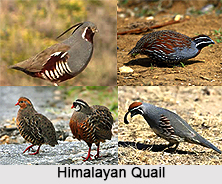 Himalayan quail with a scientific name Ophrysia superciliosa, or mountain quail is a medium-sized quail belonging to the pheasant family.
Himalayan quail with a scientific name Ophrysia superciliosa, or mountain quail is a medium-sized quail belonging to the pheasant family.
Himalayan quail as Endangered Species
Himalayan quail was last reported in 1876 and is feared extinct. This species was known from only 2 locations (and 12 specimens) in the western Himalayas in Uttarakhand, north-west India. The last verifiable record was in 1876 near the hill station of Mussoorie.
Structure of Himalayan Quail
Himalayan quail has the red bill and legs of this small dark quail and white spots before and after the eye make it distinctive. The male is dark grey with bleak streaks and a white forehead and supercilium. The female is brownish with dark streaks and greyish brow. Like the male it has a white spot in front of the eye and a larger one behind the eye. It is believed to fly only when flushed at close quarters and was found in coveys of five or six. The habitat was steep hillsides covered by long grass. The genus name is derived from Ophrys which refers the brow. This quail has long tail coverts and the 10 feathered tail is longer, nearly as long as the wing, than in most quails. The feathers of the forehead and bristly and stiff.
Evolution of Himalayan quail
The species, Himalayan quail was described in 1846 by J. E. Gray from living specimens in the collection of the Earl of Derby at Knowsley Hall, and he gave the locality as "India" with a query. It was not until 1865 that it was first found in the wild by Kenneth Mackinnon who shot a pair in November, in a hollow between Budraj and Benog, behind Mussoorie, at about 6,000 feet (1,800 m) elevation. Two years later, again in November, five specimens were obtained by a group near Jerepani. In December 1876, Major G. Carwithen obtained a specimen from the eastern slopes of Sher-ka-danda, close to Nainital, at an elevation of 7,000 feet (2,100 m). Frank Finn suggested that it was a migratory bird, arriving in winter, although expressing doubts on account of the short wings. The birds near Mussoorie as observed by Hutton and others occurred in small coveys of six to ten, that kept to high grass and scrub, fed on seeds of grass, were difficult to flush, and had a shrill whistling note when flushed. They appeared to arrive about November, but in one case stayed as late as June, after which they disappeared.
The Himalayan Quail has not been reliably recorded in the wild after 1876. The locations where they were historically found have been greatly altered by human activity and the current habitats in these locations may not represent their normal habitat requirements. A 2015 study examined the rate of extinction and suggested that the species might still be extant and using the habitat preference of monal suggest that there might some locations around Mussoorie, Uttarakhand where intensive surveys could be attempted.











